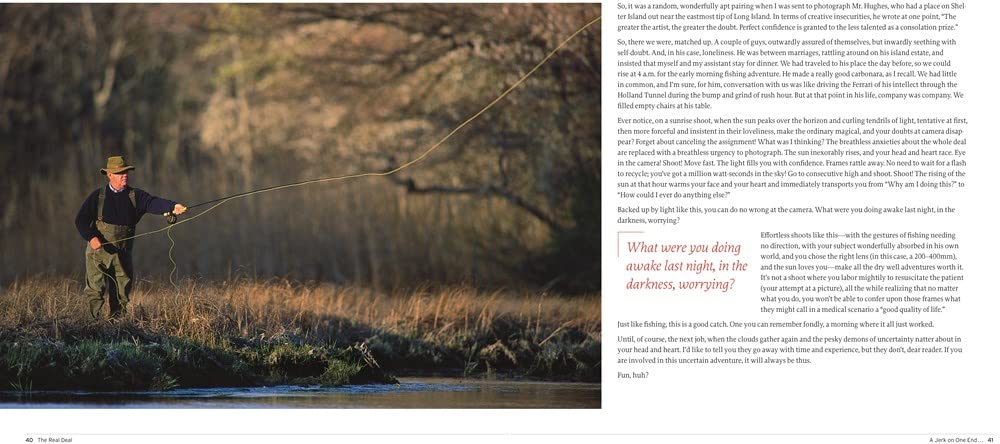Thank you for visiting!
Below you’ll find some awesome book ideas for Dad!
Joe McNally has enjoyed a long photography career that we really can only dream of. Here, in this lavish and lovely coffee table book, he offers his collection and recollections from his amazing decades-long career. And, wow, his photos are amazing! They really run the gamut, although they revolve around portraiture within natural and staged sittings — whether it’s a blackened miners, working deep in a coal mine, or an anxious Vietnamese bride on her wedding night, or an elegant ballerina, perched on the hood of a sports car, parked on a busy city street.
His memories are well written and valuable — documenting the sort of work that no longer exists, from clients now caught up in a race to the bottom. He includes a few (unpaid) billings and a $0.17 check for his stock photography. Yet it is his wonderfully informative reflections on behind-the-scene practical concerns, like how much smoke to add to the room before it takes over the photos, proper (and improper) lighting, and what to do — or not — to create a memorable photo. His whole book, and indeed his whole career, are wonderfully memorable. I love and appreciate this engaging and enlightening memoir.
This is an insightful photography book, geared toward photographers (and would-be photographers), yet it encompasses many aspects of living well to explain the underlying principles and practices of good photography. The writing is beautiful, as are the photos, including those from him and other accomplished professional photographers. His philosophy, to me at least, seems to be more about exploring (and capturing) questions than it is of finding concrete answers. The book includes about 60 brief essays, on a given topic, with both tips and treatises included, alongside a photo which poses a similar question.
The essay titles may help to show how evocative each essay is, which include, Seeing from the Body, Attention and Distraction, Minding the Darkness, The Potency of Metaphor, The Art of Inseeing, The Wisdom of Chance, Hope and Despair, Wholeness and Order, Art is a Lie That Tells the Truth, When to Put the Camera Down, and the Power of Art. This is a book that offers far more answers for than I first realized, as it poses questions that I never realized I should ask. It is a wonderful, moving, and powerful book.
This is a small boxed set of trivia cards, with a simple game to play. Yet they’re so much more. I’m not as much a photography fan as my husband is, yet I still found these remarkably well-written and -researched questions intriguing and fascinating. I found myself drawn into the next card, then the next, delighted with the questions and answers, and often searching online for more information. For example, “In what year was the first photo taken that showed the curve of the earth?”
It was 1935; I had to go see that one online, where you can see layers of the Earth’s atmosphere, too. “What is the collection of mugshots of criminals used in police stations called? (A rogues’ gallery.) I learned more about the surrealist photographer, Man Ray, that the first color photo was taken in 1861, yet the first color photosystem available for amateur use, Autochrome, wasn’t offered in 1979. The cards themselves are thick, with an eggshell varnished finish, printed in the highest quality, with excellent design as well. For photographers, designers, or any trivia buff, these would be a fantastic gift. My husband is delighted — and so am I!
This is one of the finest photography guides I’ve ever read. Most photo guides dig into the technical specifics, which is certainly great for professionals, but what if you aren’t a professional? And don’t need (or want) to become one? But would like to take photos as good as one? This is the book for you. And me! Each page offers a (beautiful!) sample photo at the top, and then below, the helpful text explains how to achieve the look seen above. It’s written in personal, friendly, easy-to-understand English.
I love the composition chapter, for instance, which explains on one page, “Avoid Junk Around the Edges,” and on the next, to “Simplify the Scene.” The advice on how to take tourist-free photos was also remarkably easy to use — wake up early! Each page offers easy, simple advice that, despite its simplicity, has elevated my photography remarkably. Each chapter offers worlds of real-life experience, easily read, absorbed, and put to use. I’m still not a professional photographer; my photos just look like it!
My husband enjoys LEGO bricks, and our kids do, too. I wish there was more overlap, though, in their building, so they weren’t just building bricks, but building their relationship as well. We have brick building guides galore, yet they seem to revolve around very sophisticated projects, taking hundreds of bricks, with many, many steps along the way. So this guidebook happily offers projects that bridge that gap as something they can do together. The plans are clever yet pretty short, with a few basic steps, which also offer some variance without frustration.
For example, within minutes, my husband and son started building the “Phone Speaker” for the bathroom, which is basically a (waterproof) phone holder that focuses the sound so it’s loud enough to be heard in the shower. Straightforward in concept and execution, yet it now has a treasured, enduring location near the shower. My kids and I also made the “Photo Frame” for the family, which I glued some magnets on and it now resides on our refrigerator, permanently. The book is beautiful and well written, photographed, printed, and bound. It’s a treasure trove that helping us, as a family, to treasure our time together creating brick-made treasures of our own.






